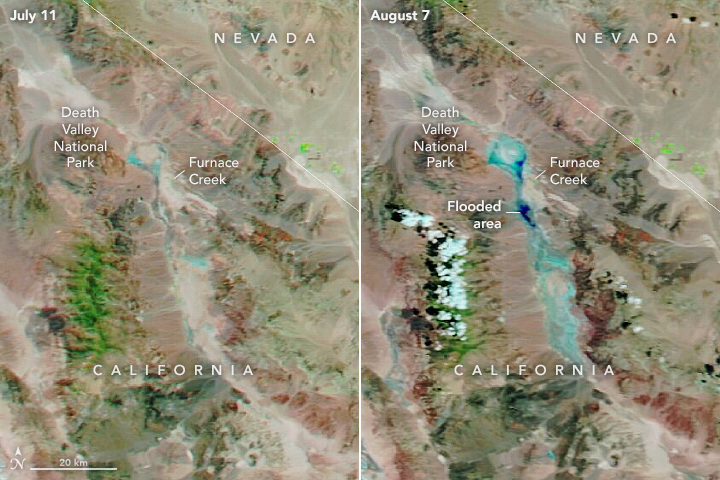


In early August 2022, flash floods soaked Furnace Creek in Death Valley, the driest place in North America. In just three hours on August 5, a thousand-year rainfall event dropped 75 percent of the local average annual rainfall, which is just under 2 inches (5 centimeters). Flood water washed debris over roads, swept away and buried cars, knocked a water facility offline, damaged buildings, and stranded about a thousand visitors and staff in Death Valley National Park.
The deluge dropped 1.46 inches (3.7 centimeters), which came close to breaking the single-day record for highest rainfall ever received in the park, which was 1.47 inches in April 1988. It did, however, break the record for the most rain recorded in August, which averages just over a tenth of an inch for the whole month.
By August 6, the flood water had mostly receded, and the stranded visitors were able to exit the park escorted by National Park Service personnel. But extensive mud and gravel deposits still remained, leaving some roads impassable; they were expected to remain closed into mid-August, according to a statement by the Park Service.
Some of the flood water is visible in the latter of this pair of false-color images acquired by the Moderate Resolution Imaging Spectroradiometer (MODIS) on NASA’s Terra and Aqua satellites on July 11 and August 7, 2022. The false-color images were composed from a combination of infrared and visible light (MODIS bands 7-2-1), to make it easier to distinguish the water. Flood water appears dark blue; saturated soil is light blue; vegetation is bright green; and bare ground is brown.
At 282 feet (86 meters) below sea level, Death Valley might be expected to be filled with water. But the desert is subject to a rain shadow effect, as humid air masses traveling east from the Pacific Ocean must cross four mountain ranges before they reach the desert valley. As the air masses are forced up and over the mountains, the moisture they carry condenses and falls as rain on the western slopes, leaving a dry area, or rain shadow, on the eastern side. By the time most air masses reach Death Valley, they are bone dry.
On rare occasions, the lowest spot in the valley fills with a wide, shallow lake, dubbed Lake Badwater. Extreme heat and aridity usually evaporate the ephemeral lake quickly, returning the valley floor to a salt-caked playa.
Summer temperatures in Death Valley National Park can soar to 120°F (49°C). The highest air temperature in world history, 134°F (57°C), was recorded at Furnace Creek on July 10, 1913. The second-hottest temperature ever recorded in the park, 130°F (54°C), occurred on August 16, 2020.
NASA Earth Observatory image by Lauren Dauphin, using MODIS data from NASA EOSDIS LANCE and GIBS/Worldview. Story by Sara E. Pratt.